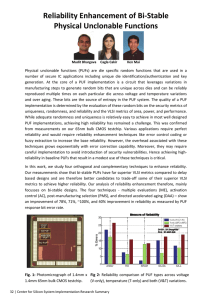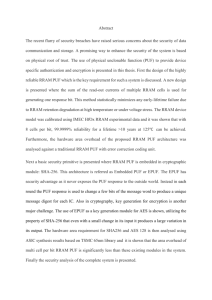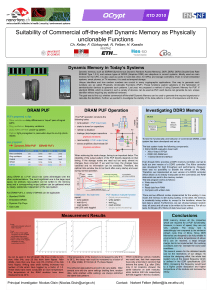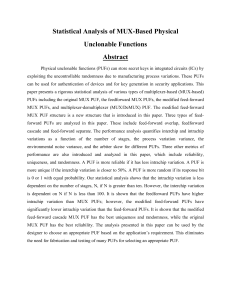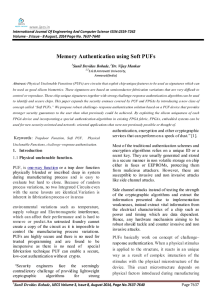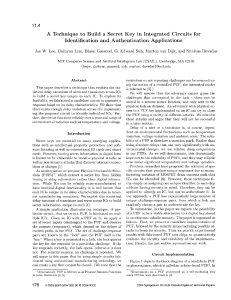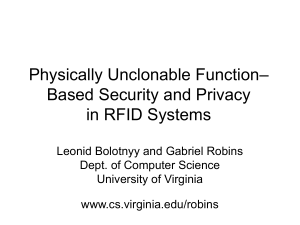public_preprop
advertisement
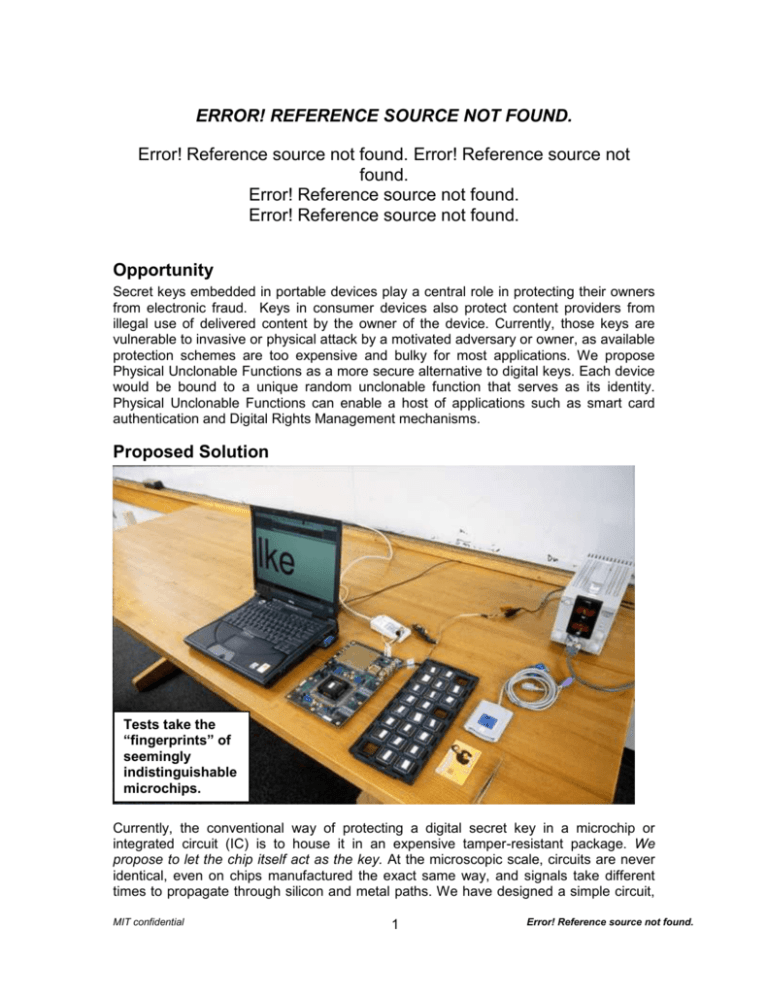
ERROR! REFERENCE SOURCE NOT FOUND. Error! Reference source not found. Error! Reference source not found. Error! Reference source not found. Error! Reference source not found. Opportunity Secret keys embedded in portable devices play a central role in protecting their owners from electronic fraud. Keys in consumer devices also protect content providers from illegal use of delivered content by the owner of the device. Currently, those keys are vulnerable to invasive or physical attack by a motivated adversary or owner, as available protection schemes are too expensive and bulky for most applications. We propose Physical Unclonable Functions as a more secure alternative to digital keys. Each device would be bound to a unique random unclonable function that serves as its identity. Physical Unclonable Functions can enable a host of applications such as smart card authentication and Digital Rights Management mechanisms. Proposed Solution Tests take the “fingerprints” of seemingly indistinguishable microchips. Currently, the conventional way of protecting a digital secret key in a microchip or integrated circuit (IC) is to house it in an expensive tamper-resistant package. We propose to let the chip itself act as the key. At the microscopic scale, circuits are never identical, even on chips manufactured the exact same way, and signals take different times to propagate through silicon and metal paths. We have designed a simple circuit, MIT confidential 1 Error! Reference source not found. termed a Physical Unclonable Function (PUF), which has a huge (264) number of paths and a sub-circuit that acts as a stopwatch. Different inputs to the PUF excite different paths in the PUF. By timing the delays along a few hundred of the paths, we can generate a unique fingerprint for each apparently identical chip. That fingerprint – recorded when the chip is made and stored in a database – can act as a key to, for instance, unlock proprietary software, or authenticate an online transaction.1 We have implemented the PUF on many supposedly identical2 integrated circuits, fabricated using a 0.18 TSMC process, and shown that manufacturing processes contain enough variability for path-delays to uniquely characterize each integrated circuit. Since these variations are not under control of the manufacturer, we have the unique property that not even the manufacturer can choose to produce indistinguishable devices. Since delays change with environmental conditions, we make relative comparisons of path delays to compensate for environmental variation such as temperature and voltage levels. Then main research that needs to be carried out is to make PUFs reliable to significant environmental variations using compensated delay measurement. Physical attacks on the microchip will destroy the PUF because the delays of the wires will change when metal wires are removed. There is no digital key to discover. Noninvasive attacks to characterize the PUF delays and create a software delay model (or clone) of the PUF will have to be very precise because small inaccuracies in delays in the model will not be tolerated during authentication. We are researching ways to increase the complexity of software modeling, thereby increasing PUF security. Impact The simplest and perhaps immediate application of this work is to try to create smart cards that are unclonable. The smart card has a microchip with a PUF on it. Before the PUF-card is sent to the user, the card company, e.g., VISA, creates a large set of challenge-response pairs for the PUF-card and stores them in a secure database. These challenge-response pairs are merely inputs to the PUF-card and the outputs that the PUF-card generates for those inputs. Each time the user uses the card, the card reader queries the card for the responses to a small set of challenges in the stored database. If the PUF-card responds correctly the transaction is authorized. The challenges used are never repeated to protect against eavesdroppers. Thus, if the smart card user misplaces his card and then retrieves it, he can still keep using it because the “key” in the card cannot have been discovered. He/she can even lend it to a “friend” without causing a permanent breach of security. In addition to the above authenticated identification application, if a processor-PUF is built, i.e., a programmable processor with a PUF embedded in it, a host of other applications are possible. For example, we can build phone cards, where after making a phone call, it is guaranteed that the appropriate number of minutes will be subtracted from the purchased minutes. We can also create software that only runs on the processor-PUF. This is useful when proprietary software needs to be copy-protected. 1 This description is taken from the Prototype section, MIT Technology Review, November 2003. The integrated circuits are identical in the sense that they had identical mask layouts and were fabricated on the same wafer. 2 MIT confidential 2 Error! Reference source not found. This secure processor-PUF can potentially be used in set-top boxes, or as a secure coprocessor in a game console. Deliverables We have already built a simple PUF on custom silicon and are currently experimenting with it, and developing techniques to improve its reliability and security. A processorPUF implemented on custom silicon is the major deliverable for this project. Commercialization Once the technology is proven to be secure and reliable, the next step is to focus on one particular application of this technology. Smart card and credit card manufacturers may be interested in licensing the basic PUF technology. Embedded processors are used in many products, and secure embedded processor-PUFs should be attractive to a host of companies. We believe that the connections and partnerships that the Deshpande Center brings can be very helpful in identifying the first users of this technology. Prior Art Statistical variation has been exploited to create IC identification circuits that generate a single unique response for each manufactured IC. This approach can identify an IC but cannot authenticate it, since once the IC outputs its digital response, any other device can store it. Our contribution is to show that by exploiting statistical delay variation and measuring transient response, one can generate a unique fingerprint for an IC that cannot be cloned even by the manufacturer. Further, we can embed the PUF in a processor to enable a host of applications, as described above. A patent titled, “Identification and Authentication of Integrated Circuits” was filed in April 2003. Collaborations and Funding I have an NSF contract that began in September 2003 that partially funds this work. The Oxygen project at CSAIL has also partially funded this work, but that funding may not continue in 2004-05. My students and I have collaborated with Marten van Dijk of Philips on PUF technology as part of the Oxygen project, and Philips and MIT are joint owners of the patent mentioned above. All work on PUFs has been carried out at MIT and MIT owns the IP, e.g., PUF chip design, and work done subsequent to the patent, and has third party licensing rights. MIT confidential 3 Error! Reference source not found.

